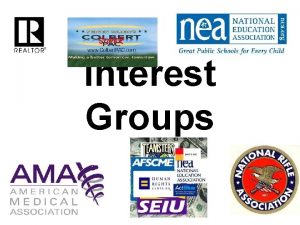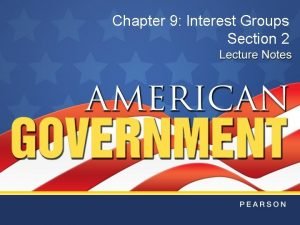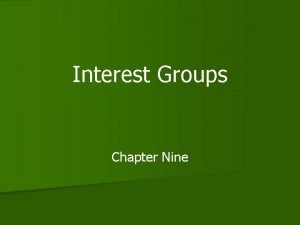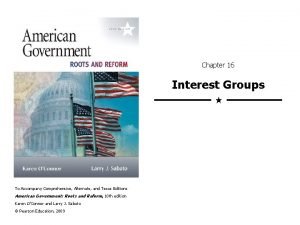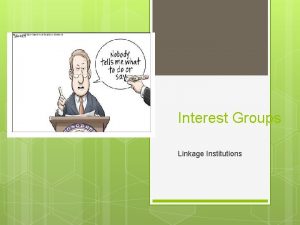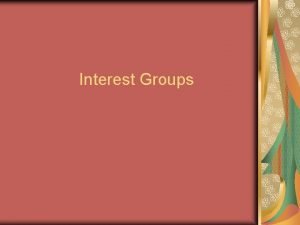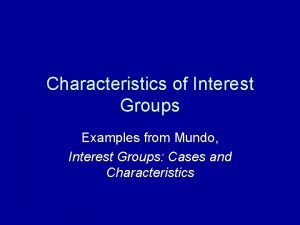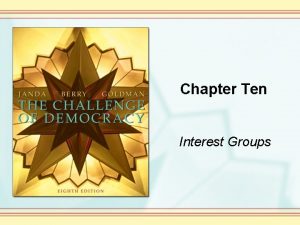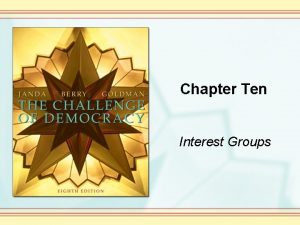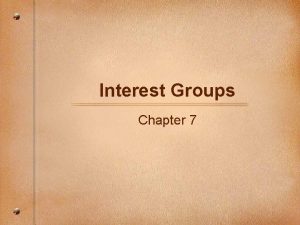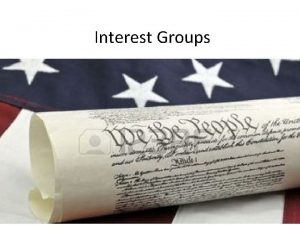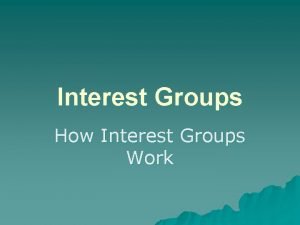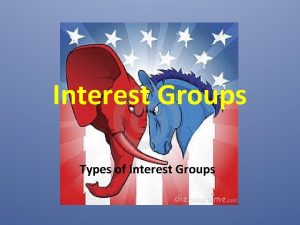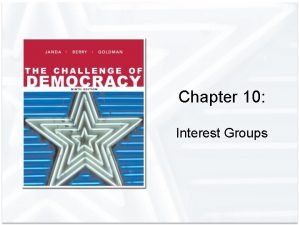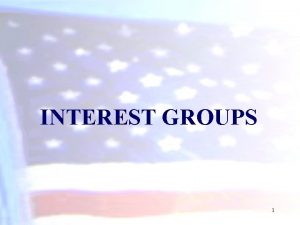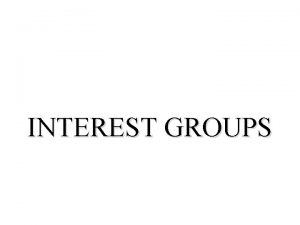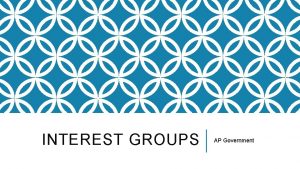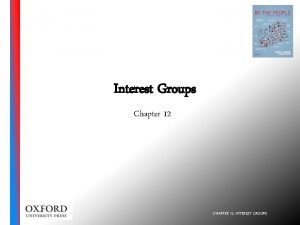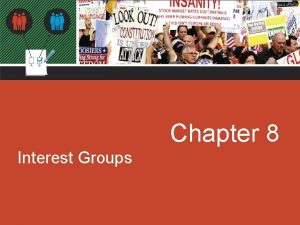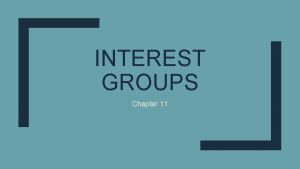Chapter Ten Interest Groups Interest Groups in America
















- Slides: 16

Chapter Ten Interest Groups

Interest Groups in America • An interest group is “an organized body of individuals who share some political goals and try to influence public policy. ” • Do interest groups contribute to the proper functioning of democracy, or are they a threat to it? Copyright © Houghton Mifflin Company. All rights reserved. 2

Interest Groups in America (Cont’d) • Interest groups play many roles in the American political system: • • • Representation Participation Education Agenda building Program monitoring Copyright © Houghton Mifflin Company. All rights reserved. 3

Figure 10. 2: Group Stimulation Copyright © Houghton Mifflin Company. All rights reserved. 4

How Interest Groups Form • Pluralists such as David Truman see interest groups naturally forming when people are adversely affected by a disturbance (disturbance theory). • Political scientist Robert Salisbury argues that the quality of leadership is a key determinant of successful interest group formation. Copyright © Houghton Mifflin Company. All rights reserved. 5

How Interest Groups Form (Cont’d) • Who is being organized is also an important force affecting group formation. • The wealthy and the well educated are more likely to form and join lobbies. Copyright © Houghton Mifflin Company. All rights reserved. 6

How Interest Groups Form (Cont’d) • Three variables help explain why groups become or do not become fully organized. • A disturbance or change may make people aware that they need political representation • The quality of leadership • The higher the socioeconomic level of potential members, the more likely those members are to join. Copyright © Houghton Mifflin Company. All rights reserved. 7

Interest Group Resources • One of the most valuable resources a group can have is a large and politically active membership. • The free rider problem is a situation in which people benefit from the activities of the organization but do not contribute to those activities. Copyright © Houghton Mifflin Company. All rights reserved. 8

Interest Group Resources (Cont’d) • Lobbyists can be either full-time employees of the organization or hired from law firms or public relations firms. • Political action committees (PACs) pool contributions from group members and donate those funds to candidates for office. Copyright © Houghton Mifflin Company. All rights reserved. 9

Lobbying Tactics • In direct lobbying, a group’s representatives have direct contact with a policymaker. • In grassroots lobbying, an interest group’s rank-and-file members, and possibly others outside the organization, try to influence government on some issue. Copyright © Houghton Mifflin Company. All rights reserved. 10

Lobbying Tactics (Cont’d) • Information campaigns are organized efforts to gain public backing by bringing the group’s views to the public’s attention. • Many lobbyists have added a range of high-techniques to their repertoire. • Lobbies use technologies like e-mail, polling, and the World Wide Web to expand their reach. Copyright © Houghton Mifflin Company. All rights reserved. 11

Lobbying Tactics (Cont’d) • High-tech lobbying has sped up the political process; groups can quickly mobilize their constituents, who can then quickly contact policymakers about impending decisions. • The Web has also allowed people to organize who might not otherwise be able to contact each other easily. Copyright © Houghton Mifflin Company. All rights reserved. 12

Lobbying Tactics (Cont’d) • Coalition building takes place when several groups join together in a lobbying campaign. Copyright © Houghton Mifflin Company. All rights reserved. 13

Interest Groups and Bias • Lobbying can be evaluated through both the pluralist and majoritarian frameworks. • Evaluating fairness in the pluralist framework requires that we take account of significant interests in the population, such as potential membership bias, citizen groups, and business mobilization. Copyright © Houghton Mifflin Company. All rights reserved. 14

Interest Groups and Bias (Cont’d) • The interest group system is tempered by the majoritarianism of elections. • The party that wins an election will have more say than its opponent in granting interest groups access, and thus in giving them a voice in policymaking. Copyright © Houghton Mifflin Company. All rights reserved. 15

Interest Groups and Bias (Cont’d) • Recent campaign finance reform and calls for public financing of congressional elections are potential methods to reduce the presumed influence of interest groups on Congress. Copyright © Houghton Mifflin Company. All rights reserved. 16
 For or against
For or against Chapter 9 section 2 types of interest groups
Chapter 9 section 2 types of interest groups Ten-twenty-thirty
Ten-twenty-thirty Ten ten siempre fuerzas y esperanza
Ten ten siempre fuerzas y esperanza Am i a 10/10
Am i a 10/10 Rap of the states
Rap of the states North america south america asia europe africa
North america south america asia europe africa Whats an onomatopeia
Whats an onomatopeia Why is it called latin america
Why is it called latin america Happening e performance
Happening e performance How are ethnic groups and religious groups related
How are ethnic groups and religious groups related Interest groups free rider problem
Interest groups free rider problem The nature of interest groups
The nature of interest groups A virtue of interest groups is that
A virtue of interest groups is that Interest groups linkage institutions
Interest groups linkage institutions Proliferation of interest groups
Proliferation of interest groups State two characteristics of interest groups
State two characteristics of interest groups
